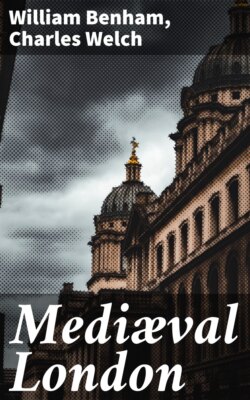Mediæval London

Реклама. ООО «ЛитРес», ИНН: 7719571260.
Оглавление
Welch Charles. Mediæval London
Mediæval London
Table of Contents
CHAPTER I
CHAPTER II
CHAPTER III
CHAPTER IV
CHAPTER V
CHAPTER VI
INDEX
Отрывок из книги
William Benham, Charles Welch
Published by Good Press, 2021
.....
First. We have the Tower on the east side, guarding the approach from the sea, and the high and spacious wall surrounding the whole city. Fitzstephen, a monk of Canterbury, gives an interesting picture of the times of Henry II. He describes London as bounded on the land side by a high and spacious wall, furnished with turrets and double gates. These were Aldgate, Bishopsgate, Cripplegate, Aldersgate, Newgate, Ludgate, and probably Bridgegate. But see Stow’s comment (Ed. Thoms, 1842, page 11). There was also a postern near the Tower. The latter he calls “the Tower Palatine,” and also names “two castles well fortified” in the west, Baynard and Montfichet. The former stood at the western extremity of the city wall on the site of the present Castle Baynard Wharf, and adjoining Carron Wharf. The name survives also in the name of “Castle Baynard Ward.” It was built by Baynard, a follower of William the Conqueror, and though it was burnt more than once, it was duly restored, and lasted till the Great Fire. It became a Royal palace, and in it Edward IV. assumed the title of King. Henry VIII. made it one of his residences. So did Edward VI., on whose death Queen Mary was here proclaimed Queen. Montfichet Tower was between the site of Ludgate Hill Station and Printing House Square. A bastion of the London Wall still remains in the churchyard of St. Giles’, Cripplegate.
Secondly. The great market-place—the Cheap—with the principal streets all leading into it, represents the commercial magnitude of the city. The residences of the merchants and traders had, for the most part, each its garden, large or small. It is a commonplace saying that there is not a street in London from some part of which you cannot see a tree. This was more true a few years ago than it is to-day. Thus, there was a beautiful plane-tree in front of Grocers’ Hall, in Princes Street, but exigencies of building-space led to its destruction but lately. Cheapside still rejoices in its fine tree at the corner of Wood Street, which has found a great poet to write pleasantly about it. Down in secluded streets the London saunterer comes on more of these trees, relics of old citizens’ gardens and resorts, as well as those in closed churchyards. The parish of St. Martin Pomeroy preserves in its second name the memory of the ancient orchard which once gladdened the Londoner’s eyes.
.....